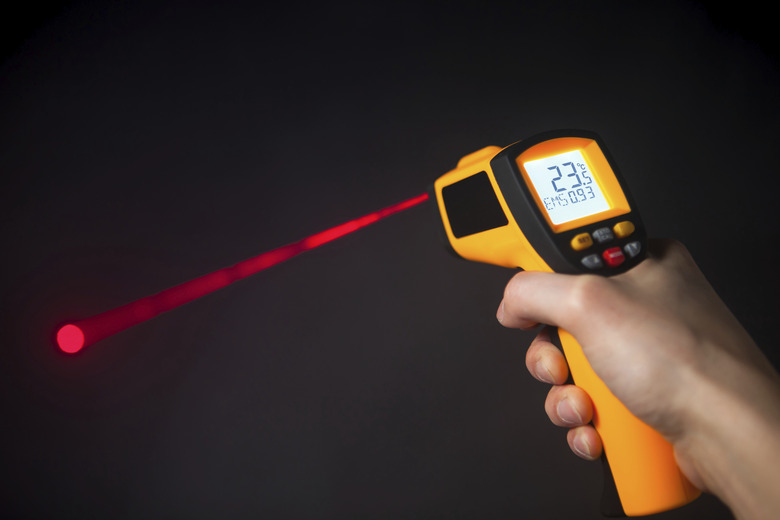How Do Laser Thermometers Work?
How Laser Thermometers Measure Temperature
How Laser Thermometers Measure Temperature
Laser thermometers are actually infrared thermometers. The laser simply provides a means to aim the thermometer. The molecules that make up objects are vibrating constantly; the hotter the molecule is, the faster it vibrates, producing invisible light in the form of infrared energy. Infrared (IR) thermometers measure the infrared energy given off by all objects. To display the temperature, the thermometer converts the infrared energy it measures into an electrical signal, which is then displayed as a temperature.
How the Thermometer Measures Infrared Energy
How the Thermometer Measures Infrared Energy
Infrared energy has a longer wavelength than visible light and is part of the electromagnetic spectrum of light, which also includes microwaves, radio waves, ultraviolet light, gamma and X-rays. Infrared energy can be measured in three ways: transmitted, reflected and emitted. IR thermometers measure the emitted energy of objects. IR thermometers use a series of lenses and mirrors to focus the emitted infrared energy onto a detector. The detector converts the emitted infrared energy into an electrical signal, which the thermometer turns into a digital temperature reading. Since all IR thermometers can detect transmitted, reflected and emitted infrared energy, the thermometer has to be calibrated using the manufacturer's directions to read emitted infrared energy only. Emitted infrared energy is the only energy that can give an accurate surface temperature reading. If the IR thermometer is to be used on multiple objects, an emitted infrared energy guide will be needed. Most objects have an emitted infrared energy of 0.95; however, some objects have a higher or lower emitted infrared energy. The guide allows the IR thermometer to be adjusted to read a specific object's emitted energy.
When to Use Your Infrared Thermometer
When to Use Your Infrared Thermometer
IR thermometers are used to measure the temperatures of very hot objects, objects in hard-to-reach places, hazardous materials and in food manufacturing to monitor the temperature of frozen and hot foods. Use the laser sight to focus on the object being measured. For an accurate temperature reading, the object being measured should fill the field of view of the IR thermometer. Dark-colored objects give the most accurate temperature reading; shiny objects may reflect infrared light back to the thermometer, which will skew the temperature readings. To get the best temperature reading from shiny objects, a portion of the object should be covered with black tape. The black tape should be allowed to come to the ambient temperature of the object before a reading is taken. Use the black tape as the target for the temperature reading. For liquid objects, just stir the liquid and then take the temperature reading. IR thermometers work at room temperature and in very cold environments. For the most accurate readings the thermometer should be the same temperature of the ambient or surrounding temperature.
Cite This Article
MLA
Contributor, . "How Do Laser Thermometers Work?" sciencing.com, https://www.sciencing.com/laser-thermometers-work-4962575/. 24 April 2017.
APA
Contributor, . (2017, April 24). How Do Laser Thermometers Work?. sciencing.com. Retrieved from https://www.sciencing.com/laser-thermometers-work-4962575/
Chicago
Contributor, . How Do Laser Thermometers Work? last modified March 24, 2022. https://www.sciencing.com/laser-thermometers-work-4962575/
